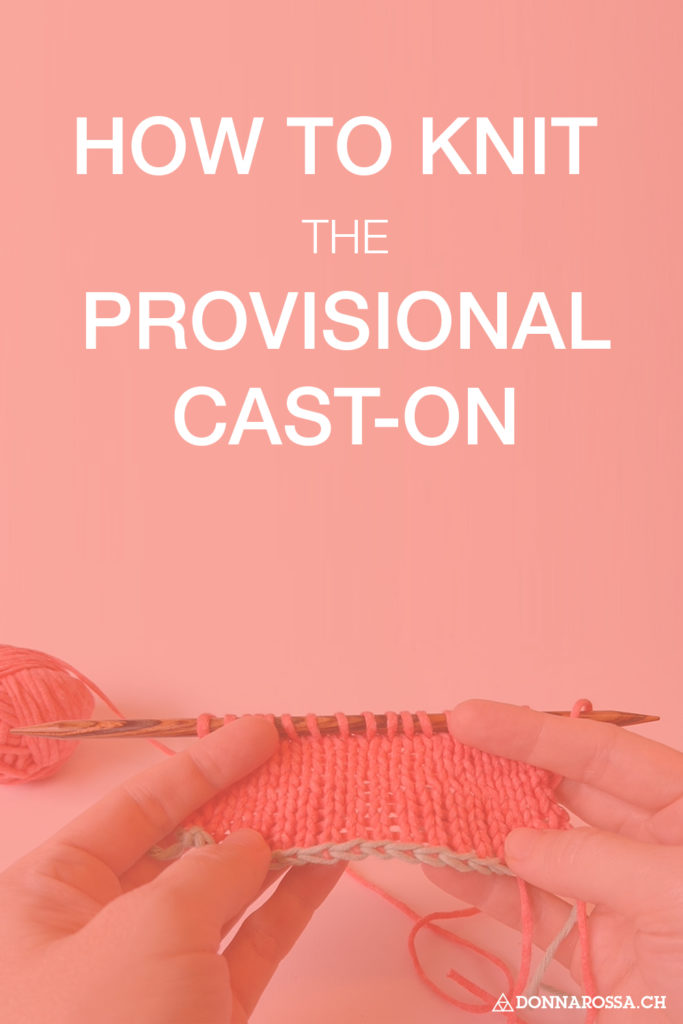When do you need the provisional cast-on? And how do you knit the provisional or chained cast-on? I show you the advantages and tips on how to work this cast-on.

When do you use the provisional cast-on? I use this cast-on when I want to knit first in one direction and later in the other direction.
Recently, I used this cast-on for a sweater which was supposed to knit bottom up. (Honestly, I prefer top-down in case I run out of yarn.) I knitted the provisional cast-on just when the sleeves and body stitches came together. Then I knitted bottom-up as the instructions said so. Later, I knitted the body and the sleeves top-down. This way I could make sure I don’t run out of yarn in the middle of the yoke.
You can also use this cast-on for decorative edge (knitting with contrasting yarn) or directly with the working yarn for a matching cast-on when you use a simple bind-off (then it’s not a provisional cast-on). This cast-on is then called chained cast-on.
There are two ways to knit the provisional cast-on
There are two ways to knit the provisional cast-on:
- crochet x amount of chain stitches, then pick up through the loops of the backside
- crochet chain stitches around the knitting needles
In the first way, you have to pick up the stitches through the chain stitches. This can get very fiddly, especially when you did the chain stitches very tight or you use a splitty waste yarn. Also, it can get annoying, if you have to cast-on a bigger amount of stitches, e.g. for the neckline of a sweater.
In the second way of the cast-on, you don’t need to pick up stitches. Compared to the first option, you already crochet around the knitting needle. I prefer this option, although in the beginning, it takes a few coordinative skills.
But before I explain to you how to do it, you have to have the right material.
What material do you need?
- working yarn
- smooth waste yarn. I recommend a smooth cotton yarn, preferably in a contrasting colour and same yarn weight or thinner as working yarn.
- knitting needle
- crochet hook, same or smaller size as the knitting needle
- scissors
How to knit the provisional cast-on
- With the waste yarn, make a slip knot and put it on the crochet hook.
- Hold the knitting needle in your left hand, together with the tail of the waste yarn.
- Wrap the thread around the knitting needle (counter-clockwise).
- Crochet a chain stitch.
- Repeat steps 3 + 4 as often as desired.
- After crocheting the last stitch around the knitting needle, do a chain stitch (not around the knitting needle).
- Cut the yarn and pull the tail through the remaining loop.
- Start to work with your main yarn.
The difference between knitting in the round and flat
You can knit the provisional cast-on for both ways of knitting: in the round and flat.
For knitting in the round, you proceed as stated above. When you start working with your main yarn, knit to the end of the provisional cast-on. Instead of turning the work – to knit flat -, you join to knit in the round.
In the video, I show you how it looks like when knitted flat. When you pick up the stitches from the provisional cast-on, be aware that stitches are shifted around a half stitch. This doesn’t impact when knitted in stockinette stitch. But in ribbing, it will be visible.
How to unravel the provisional cast-on
- Check where you finished the provisional cast-on by checking in which direction the open side of the V shows.
- Unravel the last chain stitch.
- Pick up the loops with your knitting needle, while pulling the waste yarn stitch by stitch.



Chained cast-on: how to knit it – DONNAROSSA
[…] difference to the provisional cast-on is that the chained one uses the working yarn […]
Hollie
Thank you, helpful❤️
donnarossa
You’re welcome!